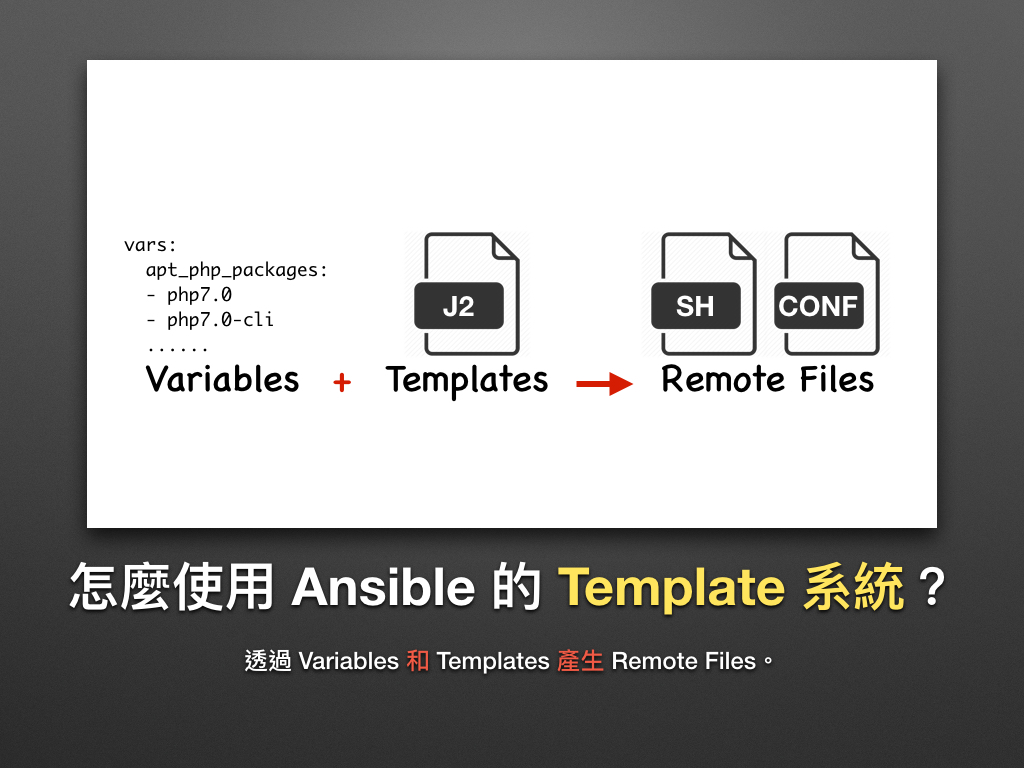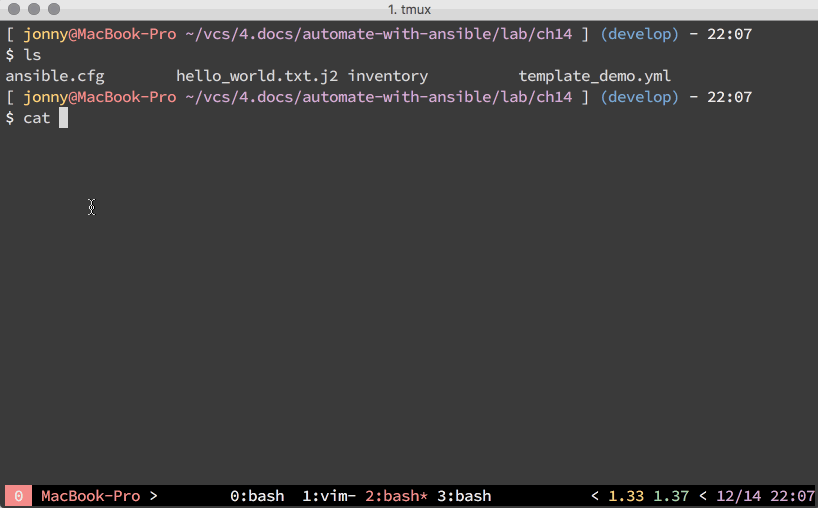
Ansible 使用 Template 系统
template module 是冻仁常用的档案模组 (Files Modules) 之一,先前在「Ansible 常用的 Ansible Module」一章时,也曾提到可以用它和变数 (Variables) 来操作档案。

图片来源:http://www.freeiconspng.com/free-images/txt-file-icon-1203
我们只需事先定义变数和模板 (Templates),即可用它动态产生远端的 Shell Scripts、设定档 (Configure) 等。换句话说,我们可以用一份 template 来产生开发 (Development)、测试 (Test) 和正式环境 (Production) 等不同的环境设定。
举例说明
说了那么多,还是让冻仁举个小例子说明吧!
- 建立 template 档案。
$ vi hello_world.txt.j2 Hello "{{ dynamic_word }}" ↑ ↑ ↑
- 由于 Ansible 是借由 Jinja2 来写作 template 系统,所以请使用 *.j2 的副档名。
- 上面的"{{ dynamic_word }}"代表我们在此 template 里使用了名为 dynamic_word 的变数。
2.建立 playbook,并加入变数。
$ vi template_demo.yml
---
- name: Play the template module
hosts: localhost
vars:
dynamic_word: "World"
tasks:
- name:
generation the hello_world.txt file
template: src: hello_world.txt.j2
dest: /tmp/hello_world.txt
- name: show file context
command: cat /tmp/hello_world.txt
register: result
- name: print stdout
debug:
msg: ""
# vim:ft=ansible :
- 在第 6 行,我们帮 dynamic_word 变数设了一个预设值 World。
- 在第 9 行的第 1 个 task 里,我们使用了 template module,并指定了档案的来源 (src) 和目的地 (dest)。
- 之后的 2 个 tasks 则是把 template module 产生出来的档案给印出来
3.执行 playbook。

- 直接执行 playbook。
$ ansible-playbook template_demo.yml
- 通过
-e 参数将 dynamic_word 覆写成 ansible。$ ansible-playbook template_demo.yml -e "dynamic_word=ansible"
- 通过
-e 参数将 dynamic_word 覆写成 Day14。$ ansible-playbook template_demo.yml -e "dynamic_word=Day14"
-e 参数将 dynamic_word 覆写成 ansible。$ ansible-playbook template_demo.yml -e "dynamic_word=ansible"-e 参数将 dynamic_word 覆写成 Day14。$ ansible-playbook template_demo.yml -e "dynamic_word=Day14"怎么让 Playbooks 切换不同的环境?
- 在 Playbooks 里除了用
vars来宣告变数以外,还可以用vars_files来 include 其它的变数档案。$ vi template_demo2.yml --- - name: Play the template module hosts: localhost vars: env: "development" vars_files: - vars/.yml tasks: - name: generation the hello_world.txt file template: src: hello_world.txt.j2 dest: /tmp/hello_world.txt - name: show file context command: cat /tmp/hello_world.txt register: result - name: print stdout debug: msg: "" # vim:ft=ansible : - 建立
vars/development.yml,vars/test.yml和vars/production.yml档案,接下来将依不同的环境 include 不同的变数档案 (vars files),这样就可以用同一份 playbook 切换环境了!
- Development
$ vi vars/development.yml
dynamic_word: "development"
- Test
$ vi vars/test.yml
dynamic_word: "test"
- Production
$ vi vars/production.yml
dynamic_word: "production"
3.执行playbook,并通过 -e 切换各个环境。

后话
template 系统是实务上很常见的手法之一,藉由它我们可以很轻鬆的让开发、测试和正式环境无缝接轨。
现在是不是有写 code 管机器的感觉了呢?(笑)
相关连结